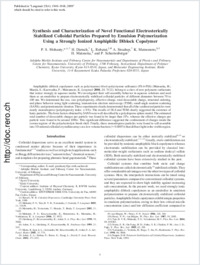Synthesis and characterization of novel functional electrosterically stabilized colloidal particles prepared by emulsion polymerization using a strongly ionized amphiphilic diblock copolymer
- Mohanty, Priti S. Institute of Physical Chemistry II, RWTH Aachen University, Germany - Adolphe Merkle Institute and Fribourg Centre for Nanomaterials, University of Fribourg, Switzerland
- Dietsch, Hervé Adolphe Merkle Institute and Fribourg Centre for Nanomaterials, University of Fribourg, Switzerland
- Rubatat, Laurent Department of Physics and Fribourg Centre for Nanomaterials, University of Fribourg, Switzerland - EPCP/IPREM UMR 5254, Unìversity de Pau, France
- Stradner, Anna Adolphe Merkle Institute and Fribourg Centre for Nanomaterials, University of Fribourg, Switzerland
- Matsumoto, K. Kyoto University, Japan - Molecular Engineering Institute, Kinki University, Japan
- Matsuoka, H. Kyoto University, Japan
- Schurtenberger, Peter Adolphe Merkle Institute and Fribourg Centre for Nanomaterials, University of Fribourg, Switzerland
-
20.01.2009
Published in:
- Langmuir. - 2009, vol. 25, no. 4, p. 1940–1948
English
Amphiphilic diblock copolymers such as poly(styrene)-block-poly(styrene sulfonate) (PS-b-PSS) (Matsuoka, H.; Maeda, S.; Kaewsaiha, P.; Matsumoto, K. Langmuir 2004, 20, 7412), belong to a class of new polymeric surfactants that ionize strongly in aqueous media. We investigated their self-assembly behavior in aqueous solutions and used them as an emulsifier to prepare electrosterically stabilized colloidal particles of different diameters between 70 to 400 nm. We determined the size, size polydispersity, effective charge, total dissociable charge, structural ordering, and phase behavior using light scattering, transmission electron microscopy (TEM), small-angle neutron scattering (SANS), and potentiometric titration. These experiments clearly demonstrated that all of the synthesized particles were nearly monodisperse (polydispersity index ≤ 6%). The results of DLS and TEM clearly suggested the existence of hairy particles. The form factors obtained by SANS were well described by a polydisperse sphere model. The estimated total number of dissociable charges per particle was found to be larger than 10⁴e, whereas the effective charges per particle were found to be around 1000e. This significant difference suggested the confinement of charges inside the corona regions of the polyelectrolyte brush shell. Finally, these monodisperse particles were found to self-assemble into 3D ordered colloidal crystalline arrays at a low volume fraction (= 0.00074) that diffract light in the visible region.
- Faculty
- Faculté des sciences et de médecine
- Department
- Département de Physique
- Language
-
- English
- Classification
- Physics
- License
- License undefined
- Identifiers
-
- RERO DOC 11811
- DOI 10.1021/la803125v
- Persistent URL
- https://folia.unifr.ch/unifr/documents/301159
Statistics
Document views: 69
File downloads:
- schurtenberger_scn.pdf: 195
